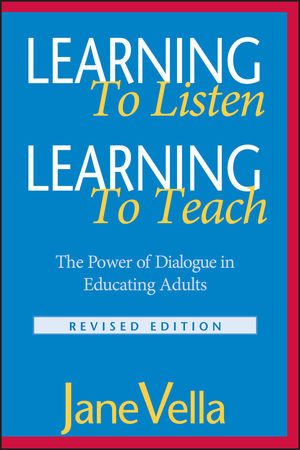Learning to Listen, Learning to Teach: The Power of Dialogue in Educating Adults, Revised EditionISBN: 978-0-7879-5967-8
Paperback
288 pages
July 2002, Jossey-Bass
 |
||||||
Foreword to the 1994 Edition (Malcolm S. Knowles).
Preface to the Revised Edition 2002.
The Author.
Part One: A Process That Works and Why.
1. Twelve Principles for Effective Adult Learning.
2. Quantum Thinking and Dialogue Education.
3. How the Principles Inform Course Design:Two Examples.
Part Two: The Principles in Practice:Across Cultures and Around the World.
4. Learning Needs and Resources Assessment:Taking the First Step in Dialogue.
5. Safety: Creating a Safe Environment for Learning.
6. Sound Relationships: Using the Power ofFriendship.
7. Sequence and Reinforcement: Supporting TheirLearning.
8. Praxis: Turning Practice into Action andReflection.
9. Learners as Decision Makers: Harnessing thePower of Self Through Respect.
10. Learning with Ideas, Feelings, and Actions:Using the Whole Person.
11. Immediacy: Teaching What Is Really Useful toLearners.
12. Assuming New Roles for Dialogue: Embracingthe Death of the Professor.
13. Teamwork: Celebrating Learning Together.
14. Engagement: Learning Actively.
15. Accountability: Knowing How They KnowThey Know.
Part Three: Becoming an EffectiveTeacher of Adults16. Reviewing the Twelve Principles and QuantumThinking.
17. How Do You Know You Know? Supposing andProposing.
Appendix: Ways of Doing Needs Assessment.
References.
Index.
Preface to the Revised Edition 2002.
The Author.
Part One: A Process That Works and Why.
1. Twelve Principles for Effective Adult Learning.
2. Quantum Thinking and Dialogue Education.
3. How the Principles Inform Course Design:Two Examples.
Part Two: The Principles in Practice:Across Cultures and Around the World.
4. Learning Needs and Resources Assessment:Taking the First Step in Dialogue.
5. Safety: Creating a Safe Environment for Learning.
6. Sound Relationships: Using the Power ofFriendship.
7. Sequence and Reinforcement: Supporting TheirLearning.
8. Praxis: Turning Practice into Action andReflection.
9. Learners as Decision Makers: Harnessing thePower of Self Through Respect.
10. Learning with Ideas, Feelings, and Actions:Using the Whole Person.
11. Immediacy: Teaching What Is Really Useful toLearners.
12. Assuming New Roles for Dialogue: Embracingthe Death of the Professor.
13. Teamwork: Celebrating Learning Together.
14. Engagement: Learning Actively.
15. Accountability: Knowing How They KnowThey Know.
Part Three: Becoming an EffectiveTeacher of Adults16. Reviewing the Twelve Principles and QuantumThinking.
17. How Do You Know You Know? Supposing andProposing.
Appendix: Ways of Doing Needs Assessment.
References.
Index.



